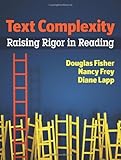Text complexity : raising rigor in reading / Douglas Fisher, Nancy Frey, and Diane Lapp.
Material type: TextPublisher: Newark, DE. : International Reading Association, [2012]Description: xi, 140 pages : illustrations ; 24 cmContent type:
TextPublisher: Newark, DE. : International Reading Association, [2012]Description: xi, 140 pages : illustrations ; 24 cmContent type: - text
- unmediated
- volume
- 0872074781 (pbk.)
- 9780872074781 (pbk.)
- 372.47 23
- LB1573.7 .F56 2012
| Item type | Current library | Call number | Status | Date due | Barcode | |
|---|---|---|---|---|---|---|
| Books | Main Library General Circulation | 372.47 F533 (Browse shelf(Opens below)) | Available | 3BPSU00042580U |
Includes bibliographical references and index.
Text complexity is the new black: -- Text complexity defined -- Revisiting how we match readers and texts -- Text complexity and the common core state standards -- The case for struggle -- Conclusion -- Quantitative measures of text complexity: -- Word-level analysis -- Sentence-level analysis --Conventional readability formulas -- Readability formulas that also measure readers -- Measuring coreference and cohesion -- Cautions and criticism of readability formulas -- Readability for early readers -- Conclusion -- Qualitative measures of text complexity: -- Considerate texts -- But not all texts are considerate -- Levels of meaning and purpose -- Structure -- Language conventionality and clarity -- Knowledge demands -- Returning to the hunger games, qualitatively -- Cautions and criticisms of qualitative analysis of text complexity -- Conclusion -- Matching readers to texts and tasks: -- Exploring the reader -- Exploring the task -- Exploring the question -- Shifting expectations -- Cautions and criticisms of matching readers with texts and tasks -- Conclusion -- A close reading of complex texts: Close reading -- Close reading up close in fourth grade : "post-it-notes" -- Close reading up close in ninth grade : "The road not taken" -- Conclusion.
The Common Core State Standards place an emphasis on teaching students to read and understand increasingly complex texts. That teaching requires more than just assigning students hard books and hoping they get better at reading. Teaching starts with a deep understanding about what makes text complex. In this book, you'll learn about the quantitative factors of text complexity as well as the ways in which readers can be matched with texts and tasks. The book focuses on instruction and assessment of complex texts through close readings and extensive discussions. With this understanding, lessons can be developed that ensure students are prepared for the wide range of reading and writing they will do for the rest of their lives.
There are no comments on this title.

